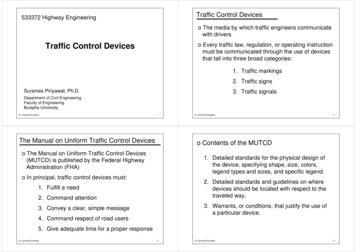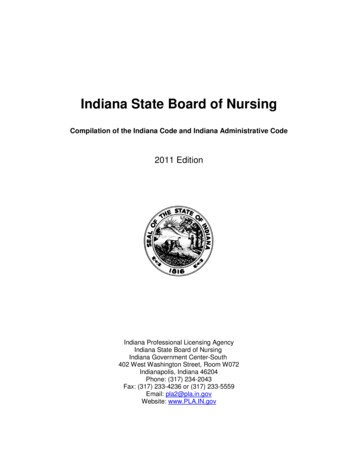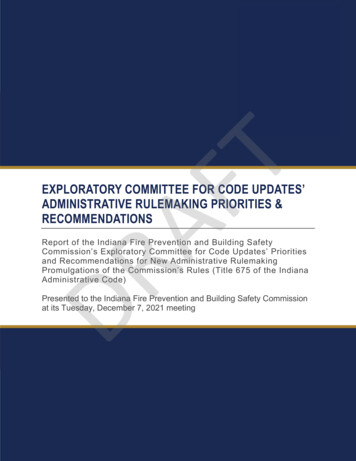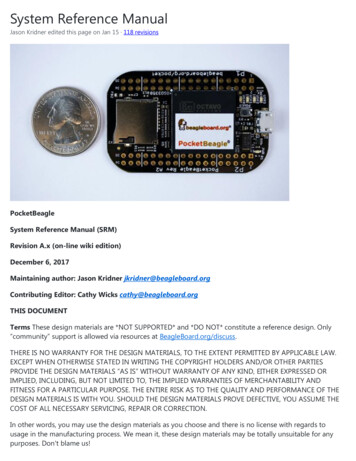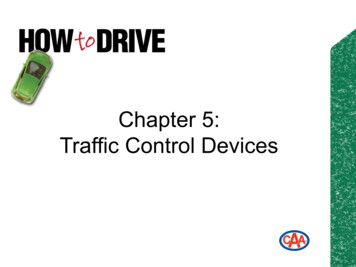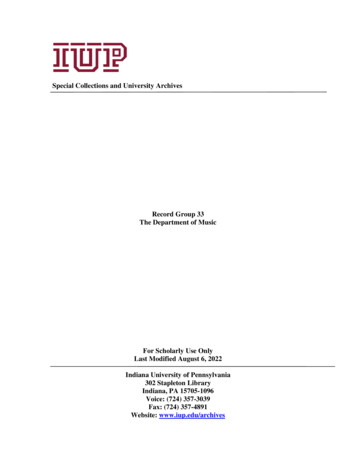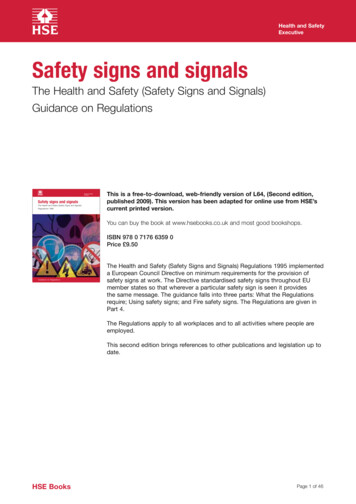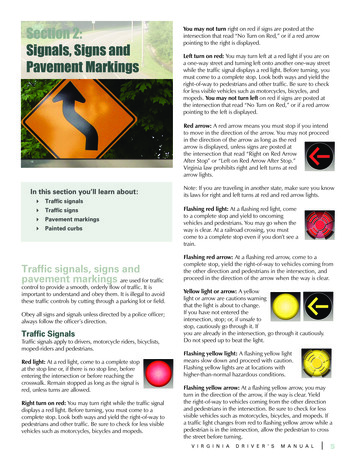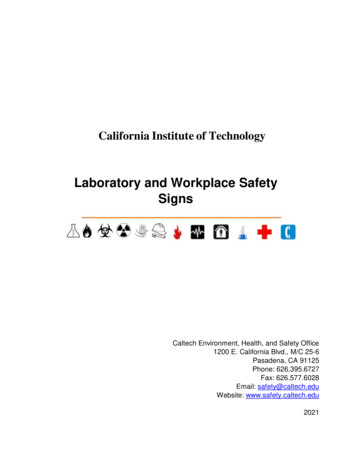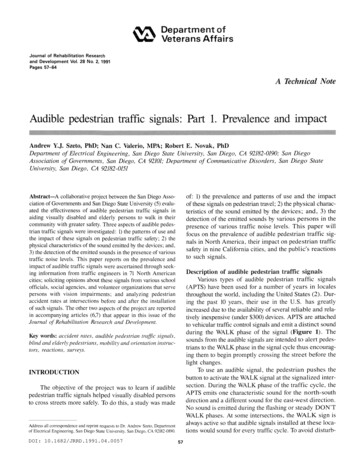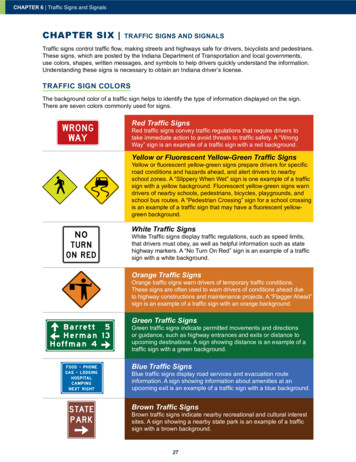
Transcription
CHAPTER 6 Traffic Signs and SignalsCHAPTER SIX TRAFFIC SIGNS AND SIGNALSTraffic signs control traffic flow, making streets and highways safe for drivers, bicyclists and pedestrians.These signs, which are posted by the Indiana Department of Transportation and local governments,use colors, shapes, written messages, and symbols to help drivers quickly understand the information.Understanding these signs is necessary to obtain an Indiana driver’s license.TRAFFIC SIGN COLORSThe background color of a traffic sign helps to identify the type of information displayed on the sign.There are seven colors commonly used for signs.Red Traffic SignsRed traffic signs convey traffic regulations that require drivers totake immediate action to avoid threats to traffic safety. A “WrongWay” sign is an example of a traffic sign with a red background.Yellow or Fluorescent Yellow-Green Traffic SignsYellow or fluorescent yellow-green signs prepare drivers for specificroad conditions and hazards ahead, and alert drivers to nearbyschool zones. A “Slippery When Wet” sign is one example of a trafficsign with a yellow background. Fluorescent yellow-green signs warndrivers of nearby schools, pedestrians, bicycles, playgrounds, andschool bus routes. A “Pedestrian Crossing” sign for a school crossingis an example of a traffic sign that may have a fluorescent yellowgreen background.White Traffic SignsWhite Traffic signs display traffic regulations, such as speed limits,that drivers must obey, as well as helpful information such as statehighway markers. A “No Turn On Red” sign is an example of a trafficsign with a white background.Orange Traffic SignsOrange traffic signs warn drivers of temporary traffic conditions.These signs are often used to warn drivers of conditions ahead dueto highway constructions and maintenance projects. A “Flagger Ahead”sign is an example of a traffic sign with an orange background.Green Traffic SignsGreen traffic signs indicate permitted movements and directionsor guidance, such as highway entrances and exits or distance toupcoming destinations. A sign showing distance is an example of atraffic sign with a green background.Blue Traffic SignsBlue traffic signs display road services and evacuation routeinformation. A sign showing information about amenities at anupcoming exit is an example of a traffic sign with a blue background.Brown Traffic SignsBrown traffic signs indicate nearby recreational and cultural interestsites. A sign showing a nearby state park is an example of a trafficsign with a brown background.27
INDIANA DRIVER’S MANUAL IN.gov/BMVTRAFFIC SIGN SHAPESThe shape of a traffic sign also indicates the type of information displayed on the sign. There are sevencommon shapes used for traffic signs.Circular Traffic SignsCircular traffic signs alert drivers to upcoming railroad crossings.Equilateral Traffic SignsTraffic signs with three sides of equal length warn drivers to slowdown when approaching an intersection, and to be prepared to cometo a complete stop in order to yield to other drivers or pedestrians.Pennant-Shaped Traffic SignsPennant-shaped traffic signs are posted on the left-hand side of twoway roads to warn drivers not to pass other vehicles on the left.Rectangular Traffic SignsRectangular traffic signs display one of three types of information.They may convey traffic regulations that drivers must obey, such asspeed limits and turn movement prohibitions like “No Left Turn.”They may provide helpful information such as route marker signsthat identify a state highway, or destination signs that give thedirection to the next town.They may also warn drivers of hazardous conditions such as anadvisory speed for a sharp curve in the roadway.This advisory speed sign is often posted with a diamond- shapedwarning sign.Diamond-Shaped Traffic SignsDiamond-shaped traffic signs warn drivers of upcoming roadconditions and hazards. A “Divided Highway Ends” sign is anexample of a diamond-shaped traffic sign.Five-Sided Traffic SignsFive-sided traffic signs warn drivers that they are entering an areanear a school in which children may be crossing the road.Eight-Sided Traffic SignsEight-sided traffic signs warn drivers that they must stop and yieldthe appropriate right of way at an intersection.28
CHAPTER 6 Traffic Signs and SignalsWarning SignsWarning signs prepare drivers for upcoming road conditions and hazards. The following signs areexamples of Indiana’s warning traffic signs:Added LaneBicycle CrossingBuggy WarningCattle CrossingNarrow BridgeDETOUR1000 FTBEPREPAREDTO STOPObject MarkersIntersectionAheadCurve AheadDeer CrossingDetour In1,000 FeetPrepare To StopSharp TurnSlow DownDivided HighwayBeginsFarmMachineryFire StationLane EndsSteepDowngradeStop AheadLanes ShiftingLow ClearanceLow ShoulderMerging TrafficTwo-Way TrafficWinding RoadPedestrianCrossingPlaygroundWarningSide RoadSlipperyWhen Wet“T” IntersectionTraffic SignalWATCHICEONFORBRIDGESWatch For IceOn BridgesYield Ahead29
INDIANA DRIVER’S MANUAL IN.gov/BMVHighway Construction and Maintenance SignsConstruction zones pose dangers both for drivers and for construction workers. Orange highwayconstruction traffic signs warn drivers to be careful when approaching construction zones.FLAGGERAHEADDetourDetour AheadRoad WorkAheadWork CrewAheadWorksite AddedPenaltiesFlagger AheadFlagger AheadRight LaneClosedRailroad SignsRailroad traffic signs alert drivers to upcoming railroad Crossing2 TRACKSRailroadCrossingSchool Zone SignsYellow or fluorescent yellow-green signs warn drivers that they are entering an area near a school inwhich children may be crossing the road.SCHOOLBUS STOPAHEADSchoolCrossingSchoolCrossingSchool BusStop AheadSchool BusStop Ahead30
CHAPTER 6 Traffic Signs and SignalsSlow-Moving Vehicle EmblemA slow-moving vehicle emblem has an orange fluorescent center and red reflective borders, andindicates a slow-moving vehicle which cannot exceed 25 miles per hour.Slow MovingVehicleSpeed Advisory SignsSpeed advisory signs may accompany some warning signs.EXITRAMP35M.P.H.15MPH45Speed AdvisoryAt ExitSpeed AdvisoryAt RoundaboutSpeed AdvisoryOn RampM.P.H.Speed LimitAheadTRAFFIC REGULATION SIGNSTraffic regulation signs regulate traffic speed as well as movement and display rules which drivers mustobey. The following signs are examples of Indiana’s traffic regulation signs:DO NOTLEFT LANEEMERGENCYSTOPPINGONLYBLOCKINTERSECTIONDo Not BlockIntersectionDo Not EnterLEFT ONGREENARROWONLYLEFTTURNSIGNALLeft On GreenArrow OnlyLeft Turn SignalMUSTTURN LEFTDo Not PassEmergencyStoppingKeep RightLEFT TURNYIELDHR2 PARKINGMINIMUMSPEEDLeft Turn Yieldon GreenLimitedParkingMinimum Speed8:30 AMTO 5:30 PMON GREEN31Left Lane MustTurn Left40Multiple Turns
INDIANA DRIVER’S MANUAL IN.gov/BMVNOPARKINGANYTIMENo Left TurnNo ParkingNo ParkingAny TimeNo Right TurnONEWAYNo U-TurnOne WayP1 HOURPAYPARKINGOne WayNo TrucksRESERVEDPARKINGReservedParkingPay ParkingRIGHT LANEMUSTTURN RIGHTRestricted LaneNo Turn On RedSLOWERTRAFFICKEEPRIGHTSPEEDZONEAHEADReserved ParkingVan AccesibleRight Lane MustTurn RightRight Lane OnlySlower TrafficKeep RightSpeed ZoneAheadStopTow-Away ZoneTurn Left OrGo ThroughTurn Right OrGo ThroughTwo-WayLeft TurnWrong WayHER EONStop HereOn RedYieldSupplemental PlaquesSupplemental plaques are sometimes added to the bottom of stop signs to indicate directions in whichthe intersection must stop.4-WAYALL WAY4-WayAll Way32
CHAPTER 6 Traffic Signs and SignalsTRAFFIC GUIDANCE SIGNSTraffic guidance signs provide drivers with information about the type of road they are traveling on,upcoming highway entrances and exits, and distances to various destinations. The following signs areexamples of Indiana’s traffic guidance signs:40INTERSTATE70AirportBus StationPostedDistances1 MILE70Highway ExitsInterstateMileageIndicatorINDIANA39 40State RoadUS HighwayDriver Services and Recreation SignsDriver services and recreation signs provide drivers with information about nearby amenities, parks andrecreational e TrailBoat RampCamping SiteFood ServicesAvailableFuel torical MarkerHospitalPlaygroundRest AreaRoad / WeatherInformationState ParkTelephoneAvailable33
INDIANA DRIVER’S MANUAL IN.gov/BMVTRAFFIC SIGNALSTraffic control devices such as stop lights and signs are used to control traffic flow and indicate right ofway at intersections and pedestrian crossings.Driving through an IntersectionA green light means go. If you are facing a green light, you have the right of way and may drive throughan intersection as long as the intersection is clear of other vehicles and pedestrians.A steady yellow light means the green light has ended and the signal is about to turn red. If you arefacing a steady yellow light, your right of way is ending. If you are approaching the intersection and aretoo close to stop safely, you may complete your movement.A red light means stop. Traffic entering an intersection from other directions has the right of way. If youare facing a red light, you may not enter the intersection until the light facing you turns green and theintersection is clear.RLEFT TURNYIELDRON GREEN YYYGGGTurning through an IntersectionIf you are facing a green arrow displayed with a red or green light, you have the right of way and mayturn through an intersection, as long as the intersection is clear.If you are facing a green light displayed without an arrow, you may turn through an intersection as longas the intersection is clear. You must yield the right of way to all oncoming traffic. Only one vehicle at atime may move into an intersection to turn left.Yellow Flashing Arrows for Turning MovementsA yellow flashing arrow for a turning movement means that you may proceed with the turnonly after you have yielded the right of way to pedestrians and oncoming traffic.If you are facing a steady yellow light or arrow, your right of way is ending.Turning through a Solid Red LightIf you are facing a red light or arrow, your right of way has ended. If you are in the middleof an intersection, you may turn once oncoming traffic has stopped. If you are facing a redlight or arrow, you may not enter the intersection until the light facing you turns green andthe intersection is clear.34
CHAPTER 6 Traffic Signs and SignalsTo turn right through an intersection with a red light or arrow, when permissible, you must come to a fullstop, check to make sure that there are no vehicles and pedestrians in the path of your turn or about toenter the path of your turn, check that there is not a “No Turn on Red” sign and use the correct lane.You may turn left through an intersection with a red light or arrow if you are turning from a one-waystreet onto a one-way street. You must also come to a full stop, check to make sure that there are novehicles and pedestrians in the path of your turn or about to enter the path of your turn, check that thereis not a “No Turn on Red” sign, and use the correct lanes.Yellow Flashing LightsA yellow flashing light displayed without an arrow at an intersection means that youshould slow down and use caution when traveling through an intersection. If turningleft, you must yield to oncoming traffic and pedestrians. All traffic on the cross street isrequired to yield the right of way to you. However, you should watch for other vehiclesor pedestrians attempting to cross the intersection.Red Flashing LightsA red flashing light at an intersection is equivalent to a stop sign and means thatyou must come to a complete stop before proceeding with caution to enter theintersection.If you are facing a red flashing light at an intersection at which cross-traffic is notrequired to stop, you may proceed only when the intersection is clear and when youwill not interfere with the right of way of cross-traffic.If you are facing a red flashing light at an intersection at which all traffic is required to stop, you mayproceed only after you have stopped and yielded the right of way to any vehicle that is already in theintersection, any vehicle that stopped before you and is entering the intersection, and any vehicle thatarrived at the same time as you and is to your right.Approaching a Red Light or Stop SignIf you are approaching a red light or a stop sign, you must stop at the solid white stop line. If there isno stop line, you should come to a complete stop perpendicular to the stop sign or before entering thecrosswalk on your side of the intersection. If there is no crosswalk, you should come to a complete stopbefore entering the intersection.Often people who are operating motorcycles, motor driven cycles and bicycles get stuck at a red lightand the signal fails to change to green. These individuals may avoid prolonged waits at red lights underthe following condition: An operator approaching an intersection controlled by a traffic signal may proceed through a steadyred light if the operator comes to a complete stop for at least two minutes and exercises due caution This rule does not apply to autocyclesApproaching a Yield SignA yield sign indicates that a driver must slow down when approaching an intersection and beprepared to come to a complete stop if a vehicle or pedestrian with the right of way is approachingfrom another direction.If you are approaching a yield sign, a vehicle approaching from another direction with the right of wayshould not have to brake to avoid a collision with you.35
INDIANA DRIVER’S MANUAL IN.gov/BMVApproaching an Intersection with Non-Operating SignalIf you are approaching an intersection with a non-operating signal, you should stop before entering theintersection. After stopping, you may proceed with caution only after you have yielded the right of way to: Cross-traffic that has already entered the intersection Any vehicle that stopped before you and is entering the intersection Any vehicle that arrived at the same time as you and is to your right Any pedestrian trafficApproaching an Intersection with No Sign or SignalBefore entering a street from an alley or driveway, you should stop and yield the right of way toother vehicles.Pedestrian SignalsPedestrian signals alert pedestrians when they may safely cross a street or intersection.Pedestrian signals display the word “WALK” or a symbol of a person walking when pedestrians maysafely cross a street or intersection. At some intersections, there is a button near the base of thepedestrian signal or stop sign that may be pushed to activate the walk signal.Pedestrian signals display the words “DON’T WALK” or a symbol of a raised hand when it is not safefor pedestrians to cross a street or intersection. The words or symbols flash to alert pedestrians that thetime in which to safely cross the street or intersection is ending.WalkWalkDon’t WalkDon’t WalkPedestrian Hybrid BeaconsA pedestrian hybrid beacon is a signal used to facilitate pedestrian crossing, and which may be found at amid-block crosswalk. The pedestrian hybrid beacon is dark unless it has been activated by a pedestrian.Once activated by a pedestrian, the pedestrian hybrid beacon will display a flashing yellow light to allowdrivers to clear the crossing. The flashing yellow will be followed by a steady yellow light to warn driversthat their right of way is ending. Then, two steady red lights will be displayed while the pedestriancrosses, and then the two red lights will flash to allow drivers to proceed through if the crossing is clearof pedestrians. The pedestrian hybrid beacon will then go dark until activated again by a pedestrian.1. Dark Until ActivatedRRRRYRYRR4SYFY5. Alternating Flashing RedDuring Pedestrian Clearance IntervalFR3. Steady Yellow2. Flashing YellowFRRRYY36SRSRY6. Dark Again Until ActivatedR4. Steady Red duringPedestrian Walk IntervalLegendSY Steady yellowFY Flashing yellowSR Steady redFR Flashing red
Fuel Services Available Handicap Parking Handicap Parking Historical Marker Hospital Playground Rest Area Road / Weather Information State Park Telephone Available TRAFFIC GUIDANCE SIGNS Traffic guidance signs provide drivers with information about the type of road they are traveling on,
